![]()
![]()
![]()
Use LEFT and RIGHT arrow keys to navigate between flashcards;
Use UP and DOWN arrow keys to flip the card;
H to show hint;
A reads text to speech;
47 Cards in this Set
- Front
- Back
- 3rd side (hint)
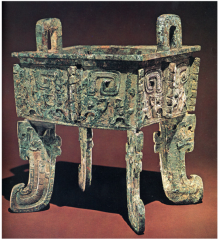
|
Title: Bronze square ding
Date: 1200 BC Culture: Chinese |
• Ding, a food container with three or four legs, was used as an integral part of different sets of bronze vessels in royal feasting, sacrifices, and funerals.
• Early bronze vessels were made with a negative shape out of wax or wood and then the metal was poured in. • Dragon face on it – story behind it is there was a dragon who had a son that was ugly and his father starved him and the dragon ate himself. Started from his tail, but he’s immortal so he ended up just being a head. • Glutton Mask • Fu Hao was a military leader as well as a consort – Renaissance woman (…..but not) • Animals and women were often shown together which is shown by the animal imagery in her tomb. • Because it’s a food vessel shows the expectation of afterlife • Inscription on the inside means “good woman” • Ears on side also serve as handles – motif of dragon is unclear and could be either one dragon or two dragons that symbolize thunder. |
|
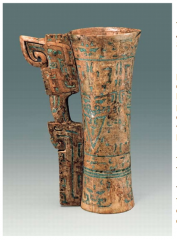
|
Title: Ivory Beaker inlaid with turquoise
Date: 1200 BC Culture: Chinese |
• The beaker has a handle in the form of a bird, and is decorated with taotie (dragon) and other monstrous motifs.
• For personal use rather than ritualistic use (which makes it different from the ding), because it was found with other personal items right on top of Fu Hao’s coffin. • Torquoise shows trade between cultures because it had to have been imported from far away |
|

|
Title: Bronze Standing Figure
Date: 1200 BC Culture: Chinese |
• Monstrous motif on the four legged pedestal
• 6-7 feet tall with pedestal (slightly under life size) large scale and distinctive eyes and noses changed aesthetics • disctinctive staring eyes, large ridged nose • tensed posture with hands holding a lost object suggests that the piece had a ritual purpose • intentionally broken in the middle, possibly for transportation • Shamanistic figure perhaps because of larger hands |
|
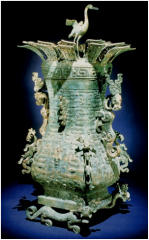
|
Title: Bronze hu
Date: 600 BC Culture: Chinese |
• Made at the time of “ritual revolution”, when political times were changing and bronze changed from being only for ritual purpose to for more aesthetic purposes. There were several warring political entities that created a “culture of competition”, and they used bronze vessels to assert their dominance and power by decorating them lavishly like this one.
• Probably a container for water/liquor (not ritual purpose) • More decorations added made possible by “lost wax” casting – create the piece out of wax, make clay model, fill with bronze |
|
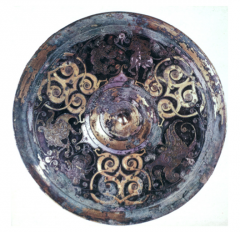
|
Title: Bronze inlaid with gold and silver
Date: 3rd century BC Culture: Chinese |
• Both functional and symbolic – symbolizes lighting the eternal darkness of the tomb by reflecting the sun, and also functional because it’s a mirror.
• “The mirror reflects ones’ heart and soul, and reflects all knowledge” • Back has an illustration king on a horse fighting a tiger • Naïve attempt at foreshortening |
|
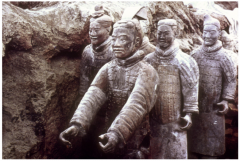
|
Title: Earthenware charioteers
Date: 3rd century Culture: Chinese |
• Idea of immortality because it was found in the tomb of the first emperor of the Qin Dynasty.
• Meant to represent an entire garrison including main army, command/HQ, infantry, and all other parts. • Large scale and number of figures shows his military accomplishments, technology, and ability to put order to warfare. • Study of grandeur after death • Production methods – made by people who made clay drainage pipes. Mass produced by having people make highly specialized pieces and then putting them all together. All shows ability to make a lot quickly, which was also shown by the use of terracotta, which was a very pragmatic material and speaks to the Emperor’s ability to command people. • • Brings in idea of mass unit versus individual heroism and power by numbers – although each sculpture wouldn’t be that impressive on its own, the unit as a whole is impressive because of how many sculptures there are. |
|
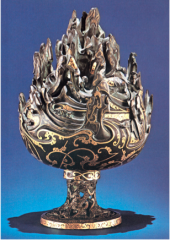
|
Title: Incense Burner
Date: 100 BC Culture: Chinese |
• The incense burner is a mini model of a legendary Daoist mountain, pierced with holes to allow smoke to go around it when incense is lit inside it. The mountain was supposed to be a paradise where the prince’s soul could stay after death with magical beasts and immortal beings.
• The smoke visualizes the qi, whose meanings range from simple vapor to breath or vitality, a concept closely related to the human soul in china’s indigenous Daoism. • Semi circular lines in upper part represent smoke • Open aesthetic goes with content • Incense was ritualistic so it serves a ritual purpose. • Shows advanced bronze casting because it’s made out of three parts • Tomb where it was found is built into the side of a mountain, adds to the idea of it being funerary art. |
|
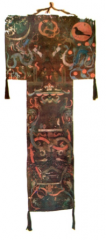
|
Title: Feiyi Banner
Date: 2nd century BC Culture: Chinese |
• Translation of feiyi is both “flying banner” and “not clothing”. There have been many different and contradicting interpretations of the object.
• Definitely served a religious purpose, but we don’t know exactly how it was used. • Could be used as a focus during mourning, a banner during procession, or a summoning garment. • Everyone is more or less in agreement that the scenes from top to bottom represent heaven, earth, and underworld. • First example of early Chinese painting |
|
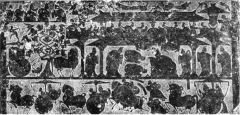
|
Title: Archer Yi, Fusang Tree, and a Reception (rubbing of stone relief)
Date: 2nd century Culture: Chinese |
• Shows change in focus from tomb to shrine, which led to mixed iconographic depictions because of the role of the shrine as linking ideas of the soul and afterlife to ideal social order on earth. Both historical and spiritual imagery was important because of that connection.
• Images show mixed iconographic agendas with Confucian and other ideals. • Story: 9 birds fly at the same time. Messes up the weather. Archer Yi kills the birds. • 3 dimensional relief sculpture was perceived as sculpture, and stylized depictions of figures show the limitations of the media. • Shows mixing of religious iconography and that Daoism and Confucianism were emerging from different places simultaneously. |
|
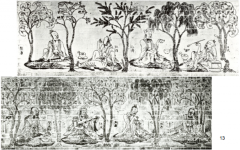
|
Title: The Seven Sages of Bamboo Grove and Rong Qiqi
Date: 4th-5th century Culture: Chinese |
• 8 drunken figures – practitioners of Daoism who reject Confucianism.
• Not didactic. Shows real historical figures. • More naturalistic depiction than work from the Qin dynasty • Less focus on recession of space than in the Archer Yi sculpture – use of space makes it naturalistic for the time. • Trees create patterned space • Human figures are at a larger scale than in earlier images, and are more individualized. |
|

|
Title: Exemplary Court Ladies
Date: 5th century Culture: Chinese |
• Found in the tomb of Sima Jinlong and his wife, who was of an ethnic minority (interracial marriage)
• Texts and subjects are mostly from the first century BC Biographies of Exemplary Women, which were moral stories about virtuous women, in their submission to men, modesty and chastity, and their role as mothers and defenders of their cultural heritage. • Scenes show Confucian ideals of women’s role in society • Style of the painting is associated with painter Gu Khaizu – no horizon line or sense of background, use of hierarchical scale, and compartmentalized composition. • Provided moral examples for later concubines • Stylized clothing – line drawing filled with color • Fabric suggests motion rather than body parts • Archaic composition which is reflected in the compartmentalization of the space (like Persian art) • Incorporates both text and image (pre literati) |
|
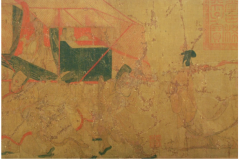
|
Title: Admonitions Scoll
Artist: Attrib. Gu Khaizu Date: 6th century Culture: Chinese |
• Teaching rules of etiquette via illustrative narrative (words and images). Text was written first and then illustrations were added.
• Audience was mainly court women • Six dynasties had a very fast rate of political change and there was a lot of friction between Confucianism and Aestheticism. • Scenes illustrate ideals of self-sacrifice, perfect female virtue, and other Confucian ideals of women. • Hand scrolls allowed you to travel through them – only saw a small part at a time, so it was sort of like reading a book. • Attributed to Gu Khaizu because it was copied from things he had made and copying was considered good art at the time. Students spent a lot of time copying master works. |
|

|
Title: Ladies Wearing Flowers in Their Hair
Artist: Attrib. Zhou Fang Date: 8th century Culture: Chinese |
• Subject is aristocratic women amusing themselves with animals – women are often shown with animals.
• Use of hierarchy and scale – women who are more important are larger and closer to us. Trying to suggest the recession of space with hierarchy and scale at the same time, makes the space sort of weird and unclear. • No individualism between the ladies, they are all exactly the same with different clothing so it showcases the fashion of the time more than the women themselves. The archetype of the women means more than the individual features. • Detail of two women with dog: they are dressed in typical clothing of the time, can see sheer fabric covering shoulders and arms and it’s less conservative than later fashions. • Media of hand scroll made the audience more limited– only wealthy people would have had access or viewed it, and the media made it so that only one or two people could view at a time, which also changed the way that art was viewed and a part of society at the ti |
|

|
Title: Early Spring
Artist: Guo Xi Date: 11th century Culture: Chinese |
• This piece is from this Northern Song dynasty, which was very influential on Chinese art in general.
• Guo Xi was an important figure at the time and was held in high honor, and he also created the idea of the artist as the heroic creator. He played a part in creating the technical vocab to criticize/discuss painting, including the idea of three distances of space (high, deep, level). He also only made landscapes. • Level distance in left middle ground, deep distance in highly tilted ground plane, high distance in monumental mountains. Different uses of space create a sense of depth, which later influenced the use of space in literati art. • Shows that Chinese society valued art because he was an artist and was held in high honor. • Example of Neo-Confucianism. Also had spiritual elements of Daoism because of the imagery of nature. |
|

|
Title: Auspicious Cranes
Artist: Emperor Huizong Painting Academy Date: 12th century Culture: Chinese |
• Scroll commemorates a time when 20 white cranes suddenly appeared over the gate of the royal palace during a festival. One of a series of “auspicious responses”, which were pieces responding to that event that showed that the cosmos approved of Emperor Huizong’s rule.
• Cranes are a symbol of Heaven’s blessing and longevity, which symbolizes the immortality of the empire. They’re shown here in accompaniment with imperial music (literally in tune with the cosmos) • Mist on ground is a symbol of immortal paradise • Use of image and text together before literati art. • Detail on roof – can see bracketing system. • Cultural reinforcement of the cosmos approval of the emperor in a time of political unrest. • Calligraphy – slender quality of calligraphy suggests an effeminate quality that implies that Huisong and his son were both bad rulers. |
|
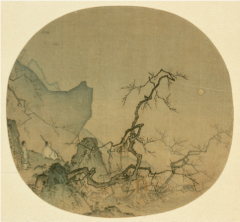
|
Title: Viewing Plum Blossoms by Moonlight
Artist: Ma Yuan Date: 12th-13th century Culture: Chinese |
• Ma-Xia school was the school of Ma Yuan and Xia Gui. Style was characterized by use of ink washes to show atmospheric perspective, leaving a lot of the composition blank, very small paintings, lots of fans, and crisp edges fading into nothing. They made paintings to order often for people of the imperial house. Use of symbolic devices was common in the Ma-Xia school.
• Plum blossom means endurance because it’s the first plant in the spring, also symbolizes female beauty and the aloof state of the idealized scholar. • Actual piece is very small, shaped like a round fan and would have been pasted onto a fan. Because it’s a fan it’s as if you had a larger landscape and were zooming in a smaller part which was common for the Ma-Xia school. • Crisp representation of landscape through angular brushwork, also use of similar ink washes in background to represent mountains. • One side of fan is image, other side is calligraphy – combination of writing and image |
|
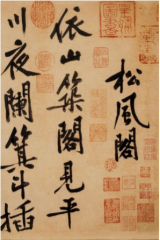
|
Title: Pine Wind Pavilion
Arist: Huang Tingjian Date: 12th century Culture: Chinese |
• Literati painting! Use of calligraphy was very important as was use of ink to create more translucent color. At that time was characterized by the fact that the artists didn’t want to get paid for their art, just wanted to make it for the sake of making it. (hipsters)
• Cursive drafting script shows mastery of calligraphy, which was important to literati art. • Stamps changed the surface as it was owned by different people. Practice of adding stamps to art in your collection was typical of the time. • Use of calligraphy was important/characteristic of literati art • Monochrome color scheme (until stamps were added), also typical of literati art. |
|
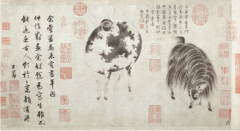
|
Title: Sheep and Goat
Artist: Zhao Mengfu Date: 13th century Culture: Chinese |
• Literati!
• Representation of the story of Su Wu, who was banished to be a shepherd for nineteen years (?) • Allegory for meeting of two historical figures – represents Confucian ideals, supposed to represent one good scholar and one bad with the sheep and the goat, but we don’t know which is which. • Combination of word and image with poetry and painting was important for literati painting, Mengfu was also the first theorist to claim that painting and calligraphy had a common origin. • Literati piece because the inscription talks about the illustration that we’re looking at and according to the inscription it mirrors ancient styles. • Stamps |
|

|
Title: Solitary Fisherman on Lake Dongting
Artist: Wu Zhen Date: 14th century Culture: Chinese |
• Literati!
• Last decades of Yuan dynasty were ever-worsening turbulence and educated men withdrew from official service and public life to remain in semi obscurity. Wu Zhen was one of those guys. He was poor but never sold his paintings, sometime presented them in exchange for gifts, but that was fine for the literati tradition because it was not on commission. • Scenery of Wu Zhen’s landscapes is his own home, and the style is unassuming and relaxed like the subject. • Monochrome ink stresses importance of weight and tone of ink. • Subdued hand fiber strokes create elongated delineation. |
|
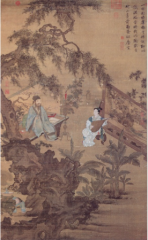
|
Title: Tao Gu Presenting a Poem
Artist: Tang Yin Date: 16th century Culture: Chinese |
• Shows Tao Gu and the courtisan Lady Qin
• Tao was arrogant to the host so court officials planned to embarrass him, he spent the night with lady Qin and she told everyone at the court and he wrote her a love poem. (basically john tucker must die), but then it backfired because the love poem became a popular song. • Between court and literati styles – First professional literati artist • Diamond shaped composition is NOT DIAGONAL WHOA CHINA • Tang Yin visited brothels often so he was good at depicting women (lol) |
|
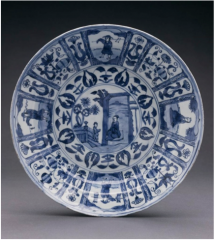
|
Title: Plate, “Kraak” porcelain painted with underglaze blue
Date: 16th – 17th century Culture: Chinese |
• Subject is miscellaneous theater, using blue to produce different tones
• Color scheme is limited like a literati painting and is also about tonality like literati paintings. • Four scenes surrounding a boy dressed like a servant • Made for export |
|

|
Title: Dwelling in the Qinbian Mountains
Artist: Dong Qichang Date: 16th -17th century Culture: Chinese |
• Literati!
• Use of three distances to create space is typical of literati art, as is the monochrome color palette and incorporation of calligraphy. • Dong was most prominent of a group of literati artists who took the rejection of “form likeness” more seriously (what) • Mountain paths that lead nowhere – shows chaotic political environment of the time. • First formalist who may have understood modern art. • Qichang broke down the style of literati so it was separated from whether the artist got paid on commission or not. |
|

|
Title: Fish and Rocks
Artist: Bada Shanren Date: 17th century Culture: Chinese |
• Artists enrolled in the academy as “amateurs” for stylistic norms regardless of money –literati and professional style were now considered stylistic equivalents regardless of the artist’s social position. No longer characterized by whether the artist was on commission or not.
• Bada took to monastic life to escape the Manchu conquest, but he also worked for commission from the elite. • Observing fish and rock from two different views – one is in bird’s eye view and one is in profile. Playing with space? • Cynical expression on fish’s face ?? fish don’t have expressions • Literati characteristics are use of calligraphy, monochrome color palette, ink washes. • Enscription is of melancholic viewpoint |
|

|
Title: The Wangchuan Villa
Artist: Wang Yuanqi Date: 18th century Culture: Chinese |
• Yuanqi was overseer of the imperial art collection, basically established a canon.
• Famous for his ink landscapes • Criticized for being “orthodox” or conservative style because it’s inspired by old rubbings. • Architectonic construction of mountains. |
|
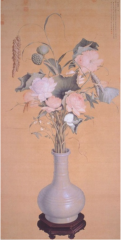
|
Title: Assembled Auspicous Objects
Artist: Guiseppe Castiglione Date: 18th century Culture: Chinese |
• Western artist working for imperial court – he adapted western methods to the traditional methods, showing the integration of western and eastern art, even though they thought that their style was better.
• Double headed rice grain = good luck and benevolent reign of new rule • Western painting was thought of as inferior to “real” painting for including expression of self and personality through visible brushstrokes. • Blossoming lotus symbolizes Buddhist enlightenment and luxurious court lifestyle. |
|
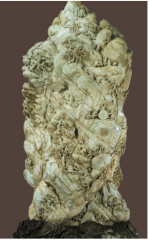
|
Title: Yu the Great Taming the Waters
Date: 18th century Culture: Chinese |
• Made out of huge jade boulder
• Largest jade sculpture in existence, took 7.5 years to finish • Made on imperial commission • The job was sent to a different city to be carved because they had better skills than the court artists. Shows court painting vs. craft skill • Hand scroll redesigned to a vertical format to mimic sculpture. |
|
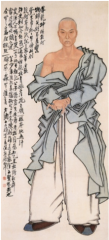
|
Title: Self Portrait
Artist: Ren Xiong Date: 19th century Culture: Chinese |
• Xiong was considered the patriarch of the Shanghai School of Painting and was best known for his portrait painting.
• Influenced by portrait photography from the west • Inscription shows loyalty to Qin Dynasty – common in literati. • Pose and costume are ambiguous • Two different codes of representation – flesh and cloth. Mixing of styles (body = western, clothing = chinese) • Calligraphy in influenced by literati style |
|
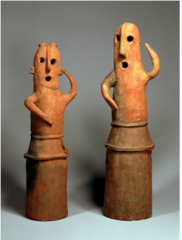
|
Title: Haniwa (clay circle) figurines
Date: 6th century Culture: Japan |
• Hollow terracotta cylinders topped with various images placed around Kofun Tumuli
• Typically found in a house directly above deceased, with human and animal figures facing outward and outlining the mound in tiers. • Prevents slop from collapsing – protect from evil spirits and erosion! • Anthropomorphized – humanoid but not specific and a lot of them don’t have ears. Not individualized, simplified with naïve facial features. |
|
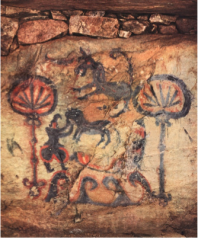
|
Title: Wall painting in the Takehara Dolmen
Date: 5th-6th century Culture: Japan |
• Shows spiritual journey
• Colors animate the scene, unusual for wall painting. • On the back wall of the tomb • Fan shaped trees define space • Wiry hair on animal suggests violence • Emphasis on skill at traveling by water because Japan is an island, so they’re good at that. |
|
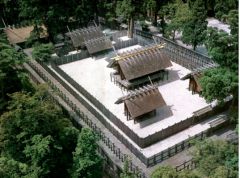
|
Title: Ise Shrine
Date: original 7th century, rebuilt every 20 years Culture: Japan |
• Shinto religion was based on a profound sense of awe for nature. Original forms of Shinto included purification of the body and mind, and reverence of sacred districts.
• Most prominent Shinto monument • 3 bays (spaces between columns on the building) wide, 2 bays deep • Built on a north-south axis with the entrance facing south • Application of gold on the surface • Resembles the Haniwa House • Native characteristics: roof with forked finials, heavy ridged pole topped by cylindrical tapered billets laid crosswire along its length, main pillars embedded in the ground, unpainted wooden components. • Lots of gold. |
|
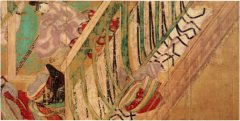
|
Title: Illustrated Scroll of the Tale of Genji
Date: 12th century Culture: Japan |
• Illustration of the Tale of Genji, a 54 chapter novel from the Heian period
• Scroll was inspired by Chinese hand scrolls and was transcribed by court ladies • Feminine style of painting (shades of color and more blocks of color, less lines). Masculine style of painting has more lines. • Three scenes that show intricacies of the Heian court • Faces – eyes are lines, hooked nose, no characterization or facial expression. • Ribbons are messed up = anxiety • Lady Naka no Kimi – made in stages with flat, opaque color and then details were added after. Shows beauty standard – chubby faces and wearing dresses. Suggests a tranquil environment but half open sliding panel suggests • Prince Genji shown holding his “son” born from his wife having an affair and looking conflicted. Can see psychological struggle by his hunched over posture • Use of blown off roof style (places the viewer above so that we are looking at it voyeuristically) |
|
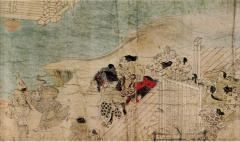
|
Title: Illustrated Scroll of the Legend of Mount Shigi
Date: 12th century Culture: Japan |
• Masculine painting style: more use of line than blocks of color, colors are more translucent
• Basic color done in watercolor • Use of bold red is different from subtle color palette of feminine painting • High vantage point • Shows Heian interest in every day matters rather than court life |
|
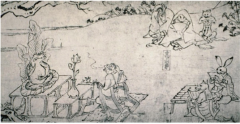
|
Title: Frolicking Animals
Date: 12th century Culture: Japan |
• Caricature to represent moral decay, eventually transformed into manga and Japanime.
• Japanese culture was more open to Caricature than Chinese, which is why anime and manga evolved in Japan and not China. • Monkey is a priest chanting to a frog Buddha with a banana leaf that represents a halo. • Mocking amorality because religiously people were “losing their morals” and not following their religion properly. • Monochrome color palette = masculine painting style |
|

|
Title: Illustrated Scroll of the Events of the Heiji Period
Date: 13th century Culture: Japan |
• During the kamakura period (samurai times), the code of the warrior and idea of heroism in battle became more important and was the major subject of narrative handscrolls.
• Illustration is based on a novel, shows the burning of the Sanjo imperial palace in Kyoto as the rebel forces try to seize power. • Dramatic visual effect highlights urgency of tactile maneuvers. • Masculine painting style • Limited palette draws attention to fire |
|

|
Title: Cypress
Artist: Attrib. Kano Eitoku Date: 16th century Culture: Japan |
• Composition influenced by the Ma-Xia school, also influenced by Chinese court painting style because of emphasis on landscape and zig-zag composition.
• Kano Eitoku created the two major kanga styles of painting (blue and gold and monochrome) • Attributed to Kano because of the use of blue and gold color palette |
|
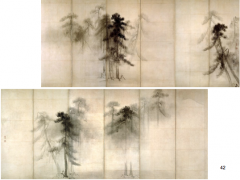
|
Title: Pine Forest
Artist: Hasegawa Tohaku Date: 16th century Culture: Japan |
• Unclear if pine tree is swaying or close or far away, purposefully ambiguous
• Spirit here is the “way of tea” – more like Zen aesthetic than Court aesthetic, contrast with extravagant court style. • Subtle use of monochrome ink with no gold background is less flashy/gaudy than court style. |
|
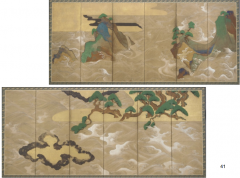
|
Title: Pine Isles
Artist: Sotatsu Date: 17th century Culture: Japan |
• Traditional masculine style of painting
• Reviving indigenous tradition and transformed it into an evocative style to keep in interesting. • Islands resemble Wedded Rocks, which are a Shinto shrine • Pair of screens, inspired by story of a banished low rank official who went home in disgrace, shown by the waves returning to shore • Shows two different perspectives of the same view ¬– one is bird’s eye, one is from the side • Meant to be read from right to left. |
|
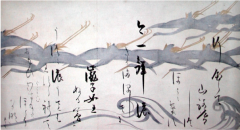
|
Title: Poems with Crane Design
Artist: Hon’ami Koetsu and Sotatsu Date: 17th century Culture: Japan |
• Made Koetsu and Soatsu – Koetsu did calligraphy, Sotatsu did the paint
• Extravagance reminds viewer of the power of the Heian court • Cranes and waves in gold and silver • Intentionally, careful overlapping of words and cranes • Rimpa style – legacy of Koetsu and Sotatsu |
|
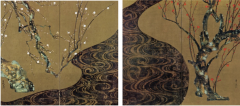
|
Title: Red and White Plum Blossoms
Artist: Ogata Korin Date: 18th century Culture: Japan |
• Folding screens
• Extravagant abstract water – Korin was known for his reworking of the decorative style and use of bright colors and gold and silver for extravagance. Also shown with the contrast in the red and white blossoms. • Rimpa style • Dripping in technique – second layer of pigment is added before the first layer dries. • Symbolism of plum blossom – first thing to flower in spring so it symbolizes endurance and feminine beauty and the aloof state of the idealized scholar. |
|
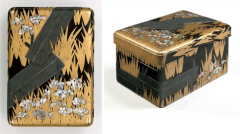
|
Title: Writing Box
Artist: Ogata Korin Date: 18th century Culture: Japan |
• Same artist as plum blossoms screen
• Shows story of irises and planked bridge which is also a banished court scholar • Irises with gold and abalone shells • 3d representation of the motif used in his paintings – shows that Korin was a versatile artist and could use many different media |
|
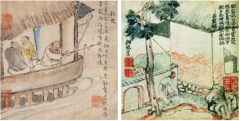
|
Title: Ten Conveniences and Ten Pleasures
Artist: Ike No Taiga and Yosa Buson Date: 18th century Culture: Japan |
• Collaboration – Buson did the bluer one and Taiga did the browner one
• About everyday scenes, strongly influenced by China because they like to focus on pleasurable activities and the everyday. • Square characters are borrowed from Chinese script • Taiga is the first Japanese person to achieve fluency in Chinese literati style, and this is one of the first examples of Japanese literati style • Shows retired life |
|
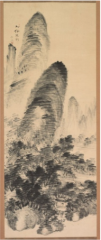
|
Title: Forbidden to the Vulgar
Artist: Uragami Gyokudo Date: 19th century Culture: Japan |
• Horizontally compressed letters indicate that it’s archaic clerical script
• Did not paint on commission – only painted to express himself (literati). • Horizontal strokes give impression of movement • Used thick lines which is different from Chinese style • Layered brushstrokes to create foliage. • Japanese literati style |
|
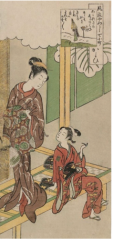
|
Title: Komachi of the Hundred Nights
Artist: Suzuki Harunobu Date: 18th century Culture: Japan |
• Subject is the most beautiful female poet, story of her and a potential lover who she made come to her house without seeing her for 100 days, and he didn’t come the last day because his father died so it didn’t work out.
• Modernized clothing for the time when it’s supposed to take place. • Potential lover is seen under an umbrella • Idealized female figures – elongated and youthful looking, not individualized • Woodblock printing was usually used for calendars, this is the first wood block print that was marketed commercially not as part of a calendar |
|
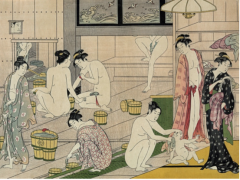
|
Title: Interior of a Bathhouse
Artist: Torii Kiyonaga Date: 18th century Culture: Japan |
• Creepy proprietor in the corner watching the women in the bathhouse.
• Admired by Degas • Spatial dissonance with oblique lines of foreground • Voyeurism was fairly typical of this kind of erotic painting (also see voyeurism in blown off roof technique) • Wood block printing |
|
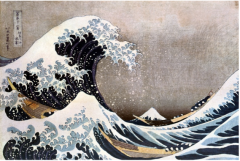
|
Title: The Great Wave at Kanagawa
Artist: Katsushika Hokusai Date: 18th-19th century Culture: Japan |
• Western influence combined with Japanese aesthetics made it universally appealing and probably contributed to its continued popularity and iconic nature.
• Wood block printing made it widely commercially marketable (easy to reproduce), and was traditionally Japanese which made it familiar to eastern audiences. • Part of a larger series of views of Mt. Fuji • Vantage point makes scene more dramatic by placing us close to the wave and far from the mountain. Emotion comes directly from landscape. • Western elements include movement from left to right, gradation in waves and sky, and use of perspective in boats and waves. • Sense of impending doom mirrors anxiety of the time. |
|
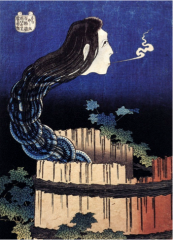
|
Title: House of Plates
Artist: Katsushika Hokusai Date: 18th-19th century Culture: Japan |
• Visual appropriation of a game – lit 100 candles, can resurrect spirits, smoke refers to counting numbers
• Was going to make 100 prints of ghost stories but stopped after making only 5 • Ghost story is that a servant girl is accused of breaking prints and thrown into a well and drowned – counts slowly in the night. • Prussian blue adds an eerie quality |
|
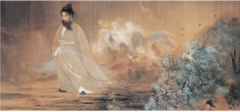
|
Title: Poet Katsugen
Artist: Yokoyama Taikan Date: 19th century Culture: Japan |
• Realist qualities of face show adaptation of naturalism and western style
• Combination of indigenous and western styles. • Subject is 3rd century poet who drowned himself because emperor didn’t like his work • Taikan wanted to preserve the indigenous style, but modernize it so it remained appealing • Murky style of painting, criticized in the west for being unspecific and blurring lines. |

